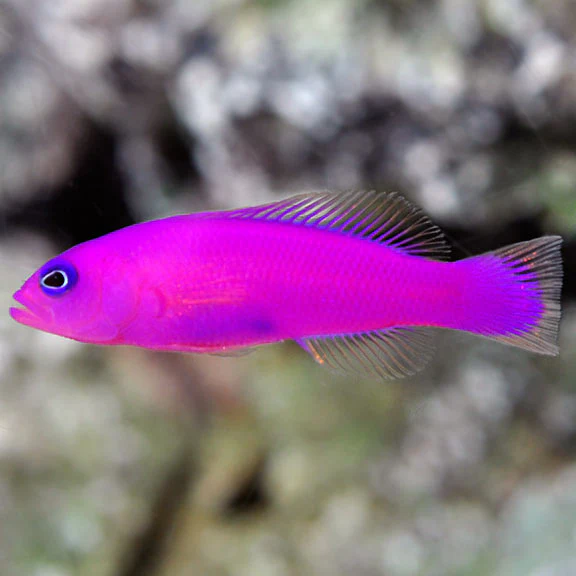Strawberry Basslet (Pictichromis porphyrea)
• Small fish safe: ⚠️ With caution (may be aggressive toward smaller or similar-sized fish)
• Small invert safe: ⚠️ With caution (may prey on small crustaceans and ornamental shrimp)
• Coral safe: ✅ Yes
• Minimum tank size: 70 liters (18 gallons)
• Adult size: Up to 8 cm (3.1 inches)
• Diet: Carnivorous, feeding on small crustaceans and zooplankton
• Be aware of: Can exhibit aggressive behavior; requires ample hiding spots; may jump out of open aquariums
Appearance and Coloration
The Magenta Dottyback is renowned for its vibrant magenta or purple coloration, which can appear more bluish under certain lighting conditions. Its slender, elongated body and striking hue make it a popular choice among marine aquarists. The species reaches up to 8 cm (3.1 inches) in length.
Natural Habitat and Behavior
Pictichromis porphyrea is native to the Western Pacific, with a range extending from the Philippines to Samoa, north to the Ryukyu Islands, and south to the Moluccas and Admiralty Islands. It inhabits coral-rich areas of reef slopes and lagoons, typically at depths ranging from 6 to 65 meters.
In the wild, the Magenta Dottyback is known for its territorial and sometimes aggressive behaviour, especially toward fish of similar size or appearance. It often establishes a home within crevices or caves in the reef structure.
Tank Requirements and Water Parameters
• Minimum Tank Size: 70 liters (18 gallons)
• Water Parameters:
• Temperature: 24°C – 26°C (75°F – 79°F)
• pH: 8.1 – 8.4
• Specific Gravity: 1.020 – 1.025
• Aquascaping:
• Incorporate ample live rock formations to provide hiding spots and establish territories.
• Ensure the presence of caves and crevices to mimic natural habitats.
• Lighting: Moderate; standard reef lighting is suitable.
• Water Movement: Moderate flow, replicating natural reef environments.
Diet and Feeding
In their natural environment, Magenta Dottybacks primarily consume small benthic crustaceans and zooplankton. In captivity:
• Captive Diet:
• Offer a variety of meaty foods such as mysis shrimp, brine shrimp, and finely chopped seafood.
• High-quality frozen or live foods can help maintain vibrant coloration and health.
• Feeding Frequency: Once or twice daily, ensuring portions are appropriate to prevent overfeeding.
Compatibility and Social Structure
• Temperament:
• Semi-aggressive, particularly toward similar-sized or passive fish.
• May exhibit territorial behavior, especially in smaller aquariums.
• Tank Mates:
• Compatible with robust, moderately aggressive species that can hold their own.
• Avoid housing with small, passive fish or species with similar coloration and shape to prevent aggression.
• Caution is advised when keeping with small ornamental shrimp or crustaceans, as they may be viewed as prey.
• Reef Compatibility: Reef-safe; does not harm corals but may pose a threat to small invertebrates.
Important Considerations
• Aggression Management: To mitigate aggressive tendencies, provide plenty of hiding spots and consider introducing the Magenta Dottyback after more passive species have established territories.
• Tank Cover: Known to jump out of open aquariums; ensure the tank is securely covered to prevent escape.
• Dietary Needs: A varied diet rich in meaty foods will support health and enhance coloration.
• Acclimation: While hardy, it’s essential to acclimate slowly to new tank conditions to reduce stress.
